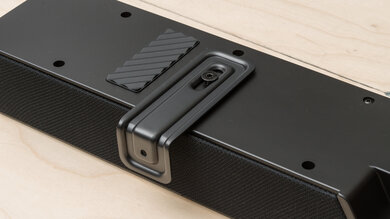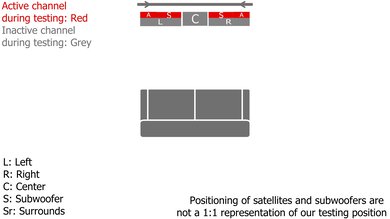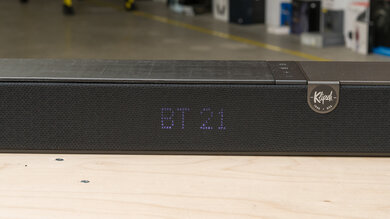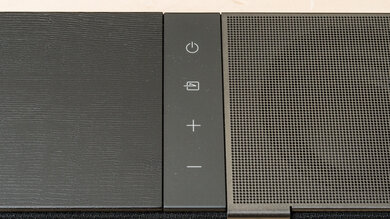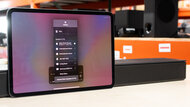The Klipsch Flexus Core 200 is a 2024 standalone 3.1.2 soundbar situated a step above the Klipsch Flexus Core 100. This bar boasts a combination of desirable features like sound customization and Dolby Atmos support in an attractively designed package. Let's find out if it's flexible enough for your space.
Our Verdict
The Klipsch Flexus Core 200 is decent for mixed usage. Thanks to its well-balanced frequency response and its plethora of sound enhancement tools like EQ and listening modes, it offers flexible functionality. Music, dialogue-heavy content, and TV shows sound clear with a fairly wide soundstage. Object-based audio formats like Dolby Atmos and Dolby Digital are on the menu, though DTS is absent. The soundbar is a bit limited by its 3.1.2 configuration for surround sound purposes, like immersive movies, and there isn't any room calibration. Gamers will have to make do without HDMI 2.1 passthrough, and it lacks DTS audio format support.
-
Balanced frequency response.
-
Discrete center channel.
-
Plenty of sound enhancement tools like EQ and listening modes.
-
No room calibration.
-
Lack of HDMI 2.1 passthrough.
-
No DTS support.
The Klipsch Flexus Core 200 is very good for TV shows and dialogue-heavy media. Its stereo frequency response has a good amount of low-end for a standalone bar, lending action-packed serials added punch. Its discrete center channel outputs natural-sounding dialogue thanks to a well-balanced mid-range. Besides that, the soundbar offers several sound enhancement tools like a 'Dialogue' mode, EQ, and a 'Night' mode, so you can binge-watch your shows without waking anybody. On the downside, it's a bit limited in connectivity by lacking an HDMI In port. It also doesn't support DTS audio formats.
-
Balanced frequency response.
-
Discrete center channel.
-
Plenty of sound enhancement tools like EQ and listening modes.
-
No room calibration.
The Klipsch Core 200 is good for listening to music. It offers a couple of listening modes for different soundstage experiences, including a 'Music' mode and a 'Movie' mode that widens the soundstage. Besides that, its integrated subs convey a good amount of punch and boom to mixes for a soundbar without an outboard subwoofer, while the EQ and EQ presets let you fine-tune the sound. The stereo frequency response plays back audio that's overall well-balanced, albeit a bit uneven in the upper frequencies. Meanwhile, it retains your music's dynamics, meaning the quiet parts sound quiet, and the loud parts sound loud. It doesn't support a large swath of wireless playback connectivity, so you're limited to Bluetooth, though.
-
Balanced frequency response.
-
Plenty of sound enhancement tools like EQ and listening modes.
-
Limited wireless connectivity.
The Klipsch Flexus Core 200 is decent for movies. Its frequency response sounds balanced for soundtracks, clear dialogue, and a good amount of low-end. Enhancement tools like EQ and listening modes help carve out a sound that fits your space and preferences, but this soundbar lacks room calibration. That said, because it's a standalone soundbar without an outboard subwoofer or satellites, it doesn't have the same degree of rumble or immersive surround sound and downmixes 5.1 audio. Dolby Atmos audio formats are supported, but there's a lack of DTS support.
-
Balanced frequency response.
-
Discrete center channel.
-
Plenty of sound enhancement tools like EQ and listening modes.
-
5.1 surround sound is downmixed.
-
No room calibration.
-
No DTS support.
- 7.4 Mixed Usage
- 7.9 Dialogue/TV Shows
- 7.5 Music
- 7.1 Movies
Changelog
-
Updated Dec 10, 2024:
We've updated the Audio Format Support: ARC/eARC and Audio Format Support: Optical scores and accompanying text in response to a Klipsch representative reaching out to clarify the sound field audio processing. Associated usage scores have been updated.
- Updated Oct 01, 2024: Review published.
- Updated Sep 24, 2024: Early access published.
- Updated Sep 16, 2024: Our testers have started testing this product.
- Updated Aug 29, 2024: The product has arrived in our lab, and our testers will start evaluating it soon.
Check Price
Differences Between Sizes And Variants
The Klipsch Flexus Core 200 is available in one color, 'Black.' You can view the label for our unit. You can also purchase the soundbar with an outboard sub (known as the Klipsch Flexus Core 200 3.1.2 System or the Klipsch Flexus Core 210). It's also available with the sub and satellites as the Klipsch Flexus Core 200 5.1.2 System.
We expect those variants to perform differently than the standalone soundbar. If you come across another different variant, let us know in the comments, and we'll add it to our review.
Compared To Other Soundbars
The Klipsch Flexus Core 200 is part of the brand's replacement of the Klipsch Cinema line. The Flexus Core 200 sits in a tier above the more affordable Klipsch Flexus Core 100 model. Unlike the step-up Klipsch Flexus Core 300 and soundbars like the Sonos Beam (Gen 2), there's no room calibration on the Klipsch Flexus Core 200, so you'll have to use the sound enhancement tools to manually adjust the sound in your space. Compared to the Sony BRAVIA Theater Bar 8, the Klipsch offers more user controls over the sound as well with a custom EQ. However, the Klipsch lacks the same degree of connectivity as the Sony, like HDMI In and HDMI 2.1 passthrough.
If you want to see what else you can get for your cash, check out the best soundbars under $500, or if you're short on space, take a look at the best all-in-one soundbars. For a comparison to which models are topping our lists, consider the best soundbars.
Depending on your usage and preferences, you may prefer the Sonos Arc or the Klipsch Flexus Core 200. The Sonos includes room calibration and creates a slightly more immersive sound, but it lacks as much user control over the sound. The Klipsch offers more hands-on control over the sound with multiple listening modes and custom EQ. It's a bit more balanced sounding but lacks room calibration.
If you're low on space, the Sonos Beam (Gen 2) may fit better than the Klipsch Flexus Core 200. Both supply wide soundstages and well-balanced sound profiles. The Sonos integrates better within your home if you have other products by the brand, or if you want wireless audio support except for Bluetooth. It also includes a room calibration feature. That said, the Klipsch features more sound enhancement tools besides room calibration. It also gets much louder to fill larger rooms and retains dynamics better than the Sonos. The Klipsch supports Bluetooth but not Apple AirPlay 2, Spotify Connect, or Wi-Fi audio like the Sonos. On the other hand, the Klipsch doesn't correctly playback Dolby Digital content panning.
Whether the Klipsch Flexus Core 200 or the Bose Smart Soundbar is better is determined mainly by your habits. The Klipsch has a bit better stereo sound and soundstage, with more bass content out of the box. However, the Bose handles surround and Dolby Atmos content better with a more balanced and immersive sound. Plus, the Bose offers greater wireless connectivity allowing you to integrate it more easily for listening to music, whereas the Klipsch is limited to Bluetooth only.
The Bose Smart Ultra Soundbar and the Klipsch Flexus Core 200 are both all-in-one designs. Choosing which is better depends on your priorities and usage habits. The Bose has a more excited V-shaped sound with fewer manual sound enhancement tools like 'Night' modes, but it includes room calibration and creates a slightly more immersive soundstage. Unlike the Klipsch, it supports more ways to connect wirelessly and integrate it into your home setup via the app. However, the Klipsch offers a better-balanced frequency response and more ways to adjust and customize the sound, except for a lack of room calibration.
For most people, the Klipsch Flexus Core 200 is better than the Sony BRAVIA Theater Bar 8. Thanks to the Klispch's well-balanced sound profile, bigger soundstage, and greater selection of sound enhancement tools, it works better for a variety of usages. On the other hand, the Sony supports more formats like DTS and DTS:X, which is more common for Blu-Rays. It also has HDMI 2.1 passthrough, and the Klipsch doesn't, which may be more useful for gaming.
Test Results
The Klipsch Flexus Core 200 is a standalone bar. You can purchase the Klipsch Flexus Sub 100 separately. The Klipsch Flexus Core 210, also known as the Klipsch Flexus Core 200 3.1.2 System (depending on the retailer), includes the subwoofer with the bar. The Klipsch Flexus Core 200 5.1.2 System includes the soundbar, satellites, and sub.
You can purchase the Klipsch Flexus SURR 100 satellites to add to the bar. The Klipsch Flexus Core 200 5.1.2 System includes the soundbar, satellites, and sub.
The Klipsch Flexus Core 200 is a hair bigger than the standalone Sony BRAVIA Theater Bar 8 and not as wide as the previous Klipsch Cinema 800. It's too wide to fit between the legs of the 65-inch TV. If you plan to place it in front of your TV on a stand, it's worth double-checking that the height won't block the bottom of your screen.
The soundbar has a good stereo frequency response. We tested it on 'Movie' mode, which offers a wider soundstage and improved tracking than 'Music' mode. However, the 'Music' mode sounds more balanced in the mids and clearer in the vocal range, but the bass isn't as powerful, and the soundstage isn't as wide as in 'Movie' mode. The EQ was left flat. The soundbar has two integrated subwoofers, so despite the lack of an outboard subwoofer, there's ample boom and punch. Mids are fairly even, though the high-mids into the low-treble are relatively recessed, leading to somewhat veiled dialogue. That said, the rest of the treble sounds rather bright and a bit piercing. You can adjust the EQ in the app as well.
You can adjust the 'Bass' and 'Treble' EQ sliders manually to fine-tune the sound in addition to EQ presets. By default, the soundbar's low-end is overemphasized, so our suggested setting reduces the 'Bass' slider to '-3' and increases 'Treble' by '1' in 'Movie' mode.
The soundbar's stereo soundstage is good. It's a bit wider than the bar's actual dimension in 'Movie' mode. It has good focus, and moving objects track well across the soundstage, so you can locate where a sound is coming from.
The stereo dynamics are very good. Most of the compression is in the bass range at max volume, causing a bit of pumping, but it's still quite good overall. At safer listening volumes, the soundbar retains your audio's dynamics well. While the bar can get loud enough to fill most rooms, in our testing, it didn't reach the 99.8 dB SPL cited by the manufacturer as the maximum output. This was double-checked across different listening modes, and sound enhancements were disabled.
The soundbar has a discrete center channel with two up-firing subs on either side of it. In all, voices sound natural, and at normal listening volumes, the audio exhibits low harmonic distortion and sounds clean. Dialogue comes through as balanced if slightly veiled in the details. Low-pitched sounds have a good amount of oomph, though they can sound a bit uneven, depending on the pitch.
The standalone soundbar plays back 5.1 surround content and downmixes it to stereo. It leans a bit warm, but it conveys a fairly balanced mid-range and a good amount of boom. That said, because it's not a full 5.1 configuration, the sound isn't as immersive as it would be with discrete satellite speakers.
The soundbar has two up-firing speakers that bounce off the ceiling to create the illusion of height with object-based audio formats. 'Movie' mode sounds more immersive than 'Music' mode. The high-bass is emphasized, and the treble is de-emphasized, which leads to dialogue and detail getting a bit lost in the mix, especially during busy scenes. On the other hand, rumble and punch in action sequences come across as immersive, though it's contending with the limitations of a bit of a lack of low-end extension without an outboard subwoofer. Moving objects track well from side to side but aren't fully immersive in depth. Height comes across decently, but it lands in front of you, rather than surrounding you from all around.
The soundbar has very good sound enhancement features. You can select between different listening modes, such as 'Movie' and 'Music,' alongside a 'Night' mode for staying on good terms with your neighbors. There are also four 'Dialog' mode strengths ('Off,' 'Low,' 'Med,' and 'High'). Besides that, the app includes EQ presets ('Flat,' 'Vocal,' 'Bass,' 'Treble,' and 'Rock'), and you can create your own custom EQ, too. You can adjust the volume levels of the drivers in the soundbar, like height volume, but the app also displays the option of level adjustment for additional speakers, whether you have satellites or an outboard sub or not. That said, there isn't a room calibration tool.
The soundbar has a single HDMI eARC port and an Optical port. It doesn't have an HDMI In port and is incompatible with HDMI 2.1. Besides that, you can connect a sub and a USB-C device, and there's a USB-A port. There's also an impulse response port for using a universal remote.
The soundbar supports Dolby Atmos and the lesser-used Dolby TrueHD format via eARC. It also supports Dolby Digital and Dolby Digital Plus, and the soundbar plays back sounds that are meant to be panned hard left/right in both channels to create the perception of a wider soundstage through a combination of phase and delay audio processing. DTS formats, commonly used on Blu-Rays, aren't supported.
The Optical connection supports Dolby Digital and two-channel PCM. The soundbar applies audio processing to create a wider soundstage through a combination of phase and delay to Dolby Digital content. The soundbar doesn't support DTS, though.
The soundbar's audio latency via the ARC port is very good. Your show's audio will mostly match the video, except for Dolby Digital's latency, which is on the higher side. Your results may vary, though, and some apps and TVs compensate for latency differently, too. Plus, you can adjust for it in the TV settings, but the companion app doesn't include an AV Sync feature.
The Optical latency is poor. It's rather high, which causes a significant lag between your audio and video. You can adjust for this in the TV settings, and latency can vary for different setups. That said, the app doesn't include an AV Sync feature.
You can pair devices like your phone and stream audio via the soundbar's Bluetooth connection.
The soundbar's remote covers most of the settings that you can also access via the companion app. It covers the essentials like volume, input sources, and 'Night' mode. The app expands the functionality, so you can access features like EQ, as shown in this tour of the app.
Comments
Klipsch Flexus Core 200: Main Discussion
Let us know why you want us to review the product here, or encourage others to vote for this product.
- 21010
Can I ask why do you recommend increasing Treble to “1” in your “Preliminary Calibration” section? I’ve recently received this model of soundbar, and I find the high frequency response to be very “bright” and the speech in movies and especially the videos (such as all YouTube videos) to have a “metallic” tonality to it, and increasing Treble only makes this more prominent and more fatiguing.
Hi RtingsUser6606815,
Good question! The primary goal of the preliminary calibration is to adjust the Slope result from our Stereo measurement to as close to 0 as possible, indicating a balanced overall tone between bass/treble.
That said, our preliminary calibration is just that, a quick calibration using built-in bass/treble sliders. It’s very limited in scope and by no means a guarantee that it will sound better in your setup or to your ears. My advice is always to trust your ears!
In this case it makes sense that you find the treble tinny and and overall bright. There’s a noticeable bump in treble response around 8kHz, but because the bass is so elevated overall the best slope we could achieve was by bumping the treble up slightly and reducing the bass significantly. An alternative would be to lower just the bass value by an extra point and keep treble at 0, or even lower bass by two points and lower treble to -1 if the high-end is still fatiguing at it’s default value. I’d suggest you play with it until you’re happy with how it sounds for your use case!
Happy listening, Matt
- 21010
Can I ask why do you recommend increasing Treble to “1” in your “Preliminary Calibration” section? I’ve recently received this model of soundbar, and I find the high frequency response to be very “bright” and the speech in movies and especially the videos (such as all YouTube videos) to have a “metallic” tonality to it, and increasing Treble only makes this more prominent and more fatiguing.
- 21010
Are there any plans to review the little brother soundbar - Core 100? If not - do you have any EQ recommendations for the Core 100 or would you feel the Core 200’s EQ settings you have listed above would be a good place to start? Thanks for all you guys do!
Hi Jako and thanks for your question and your kind words!
The Core 100 is currently in the running to be tested, though it only has one vote. It seems the Core 300 has a better chance of winning our vote at this point. Otherwise we don’t have any concrete plans to purchase it.
As for EQ settings, given the Core 100 and 200 share the same dual 4" built-in subwoofer design, I’d say the eq suggestions for the Core 200 are a great place to start. The treble might require a bit more tuning than the bass though, given the 200 has a dedicated tweeter. Hope that helps!
- 21010
Are there any plans to review the little brother soundbar - Core 100?
If not - do you have any EQ recommendations for the Core 100 or would you feel the Core 200’s EQ settings you have listed above would be a good place to start?
Thanks for all you guys do!
This product has been merged with Klipsch Flexus CORE 200 3.1.2 Channel Powered by Onky. Follow the discussion here.
- 21010
Hi, Read your review with interest. We have spent a considerable time on the Flexus range and was surprised to see the results relating to Dolby Digital Performance. In the bar, we use Dolby audio processing to create a wider sound stage and that’s why a hard left or right pan plays out of both sides. It’s using phase and delay to create a virtual sound field. Hope that helps. Regards Mike
Hi Mike,
Seeing as it’s expected behavior for creating a wider sound field, we’re going to update the supported formats section in the review to reflect why it performs that way and help clear things up.
We’ll update our documentation as well to consider this type of implementation in the future.
Cheers, Matt
- 21010
Hi, Read your review with interest.
We have spent a considerable time on the Flexus range and was surprised to see the results relating to Dolby Digital Performance. In the bar, we use Dolby audio processing to create a wider sound stage and that’s why a hard left or right pan plays out of both sides. It’s using phase and delay to create a virtual sound field.
Hope that helps.
Regards
Mike




